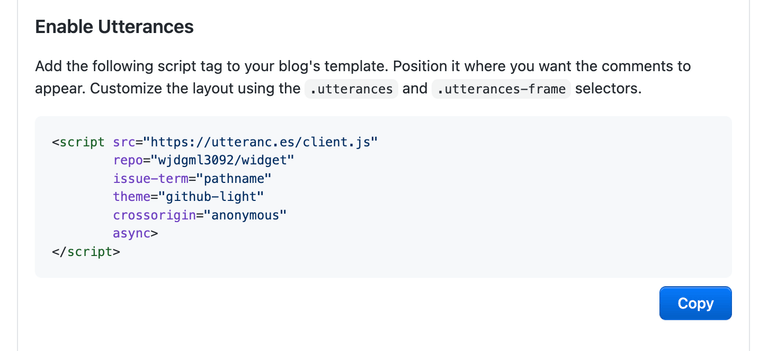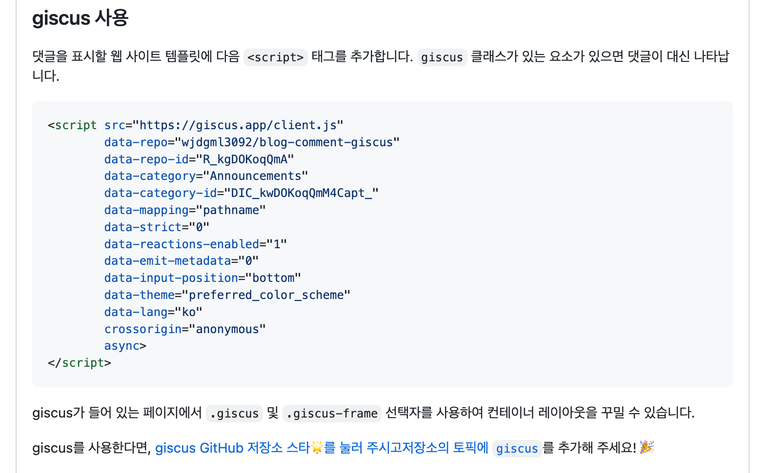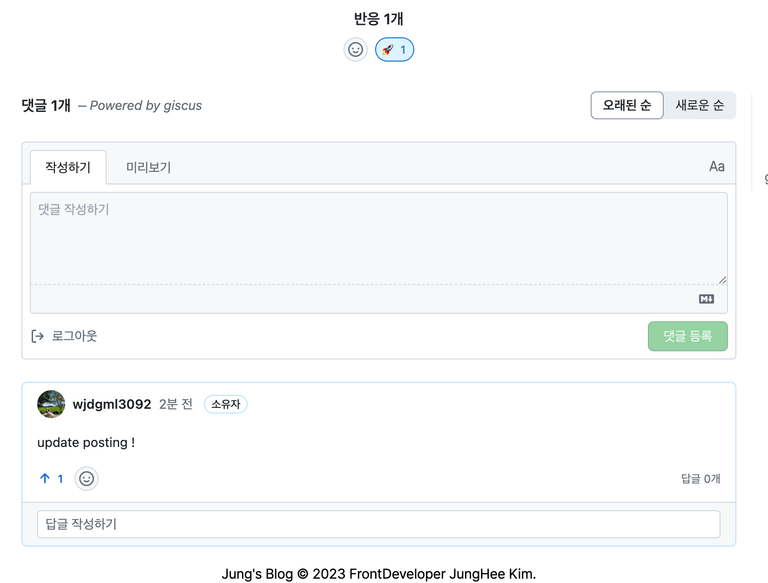개요
구현된 정적 사이트에 댓글 기능을 다는 방법은 여러가지지만 처음에는 utterances를 이용해서 배포했다. 며칠 후 giscus를 알게되어 변경했다.
giscus로 변경한 이유는 바로 아래서 설명하겠다.
utterances VS giscus
두 서비스 다 GitHub API 를 활용한 서비스인데, utterances는 Issues API 를 사용하고, giscus는 Discussions API 를 사용한다. giscus는 utterances를 기반으로 만들어진 라이브러리여서인지, 적용하는 방식은 두 서비스가 유사하다.
또한 사용 방법이 매우 쉽다.
| utterances | giscus | |
|---|---|---|
| 댓글 기능 | O | O |
| 대댓글 기능 | X | O |
| 글 리액션 기능 | X | O |
위 표에서 써져있는 것처럼 utterances에서 giscus로 변경한 이유는 대댓글기능과 글 리액션 기능이다.
utterances 적용
-
설정
-
Github에 Utterances 애플리케이션을 추가해주고, 블로그 레포지토리에 권한 설정 → 설치 링크
-
모든 레포지토리에 권한을 줘도 상관없지만, 댓글을 저장할 레포지토리를 하나 생성한 후에 이 레포지토리에만 권한을 부여하는 것을 추천한다.
-
-
구현
공식문서의 Configuration 섹션을 쭉 따라가면서 설정해주면 마지막에 script 태그를 하나 만들어준다.
(매핑 기준은 Issue title contains page pathname를 선택했다.)
라고는 적혀있지만, React 환경에서는 script 태그를 가져다 붙이는 것으로는 적용되지 않는다. useEffect 를 사용해 초기화 시 동적으로 설정하게끔 해주어야 한다.
import React, { createRef, useEffect } from 'react'
const src = 'https://utteranc.es/client.js'
const repo = 'wjdgml3092/blog-comments'
type UtterancesAttributesType = {
src: string
repo: string
'issue-term': string
label: string
theme: string
crossorigin: string
async: string
}
const CommentWidget = () => {
const element = createRef<HTMLDivElement>()
useEffect(() => {
if (element.current === null) return
const utterances: HTMLScriptElement = document.createElement('script')
const attributes: UtterancesAttributesType = {
src,
repo,
'issue-term': 'pathname',
label: 'Comment',
theme: `github-light`,
crossorigin: 'anonymous',
async: 'true',
}
Object.entries(attributes).forEach(([key, value]) => {
utterances.setAttribute(key, value)
})
element.current.appendChild(utterances)
}, [])
return <div ref={element} />
}
export default CommentWidget댓글 기능을 초기화해주는 컴포넌트를 하나 만들어주고 postContent(댓글을 넣을)부분 아래에 붙여주면 끝이다.
- 완성
giscus 적용
utterances 유사!
-
설정
- 댓글이 작성될 레포지토리 생성 (꼭, 댓글 기능을 적용하려는 프로젝트의 레포지토리가 아니어도 된다.)
- 해당 레포지토리 - [Settings] - [Features] - [Discussions] 기능을 사용하기로 체크한다.
- 댓글이 작성될 카테고리를 생성하거나 혹은 있는 카테고리를 사용해도 된다.
- giscus 설치
-
구현 공식문서의 Configuration 섹션을 쭉 따라가면서 설정해주면 마지막에 script 태그를 하나 만들어준다.
giscus도 만들어진 스크립트를 갖다 쓸 수는 없다.
(Discussion 카테고리는 만든 카테고리가 있다면 그걸로 선택, 메인 포스트에 리액션 반응 선택)
import styled from '@emotion/styled' import React, { createRef, useEffect } from 'react' const CommentWrapper = styled.div` width: 768px; margin: auto; @media (max-width: 768px) { width: 100%; padding: 15px; } ` const src = 'https://giscus.app/client.js' type GiscusAttributesType = { src: string 'data-repo': string 'data-repo-id': string 'data-category': string 'data-category-id': string 'data-mapping': string 'data-strict': string 'data-reactions-enabled': string 'data-emit-metadata': string 'data-input-position': string 'data-theme': string 'data-lang': string crossorigin: string async: string } const CommentWidget = () => { const element = createRef<HTMLDivElement>() useEffect(() => { if (element.current === null) return const giscus: HTMLScriptElement = document.createElement('script') const attributes: GiscusAttributesType = { src, 'data-repo': 'wjdgml3092/wjdgml3092.github.io', 'data-repo-id': 'R_kgDOJ0fPzg', 'data-category': 'Giscus', 'data-category-id': 'DIC_kwDOJ0fPzs4CapzG', 'data-mapping': 'pathname', 'data-strict': '0', 'data-reactions-enabled': '1', 'data-emit-metadata': '0', 'data-input-position': 'top', 'data-theme': 'preferred_color_scheme', 'data-lang': 'ko', crossorigin: 'anonymous', async: 'true', } Object.entries(attributes).forEach(([key, value]) => { giscus.setAttribute(key, value) }) element.current.appendChild(giscus) }, []) return <CommentWrapper ref={element} /> } export default CommentWidget
- 완성
마무리
giscus를 빨리 알았다면 좋았을텐데 검색을 하면 utterances 관련 글이 많이 뜬다. 그래서 이 두 가지의 차이점과 각각 적용방법을 포스팅하면 좋겠다고 생각했다. 이상 !🫡




